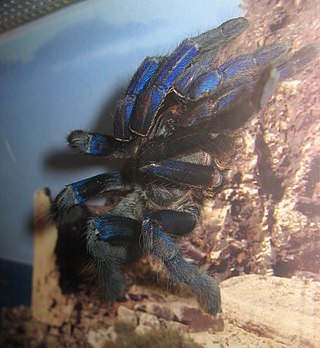
Ornithoctoninae is a subfamily of tarantulas found in Southeast Asia. It was first erected in 1895 by Reginald Innes Pocock based on the type specimen Ornithoctonus andersoni.

Selenocosmia is a genus of tarantulas that was first described by Anton Ausserer in 1871. The genus is found in China, New Guinea, Indonesia, Australia, Indonesia, Myanmar, Malaysia, Laos, Vietnam, Philippines, India and Pakistan. They are commonly referred to as whistling or barking spiders, due to their ability to stridulate using lyra hairs.

Tarantulas comprise a group of large and often hairy spiders of the family Theraphosidae. As of August 2022, 1,040 species have been identified, with 156 genera. The term "tarantula" is usually used to describe members of the family Theraphosidae, although many other members of the same infraorder (Mygalomorphae) are commonly referred to as "tarantulas" or "false tarantulas". Some of the more common species have become popular in the exotic pet trade. Many New World species kept as pets have setae known as urticating hairs that can cause irritation to the skin, and in extreme cases, cause damage to the eyes.

Selenocosmia stirlingi is a species of tarantula that is native to the arid regions of Australia. It is sometimes also referred to as a barking spider or whistling spider as this species, like many tarantulas, can stridulate to produce a "hissing" sound when disturbed or threatened. This species is largely fossorial, living in burrows deep underground, however males are sometimes encountered during the breeding season.

The Stromatopelminae are a subfamily of tarantulas native to West Africa and part of Central Africa. The subfamily was first proposed by Günter Schmidt in 1993.

The Aviculariinae are a subfamily of spiders in the family Theraphosidae (tarantulas). They can be distinguished from other theraphosids by a number of characters. Their legs have no or few spines on the underside of the tibial and metatarsal joints of the legs. The last two leg joints have brushes of hairs (scopulae) that extend sideways, particularly on the front legs, giving them a spoon-like (spatulate) appearance. Females have two completely separated spermathecae.

Cyriopagopus is a genus of southeast Asian tarantulas found from Myanmar to the Philippines. As of March 2017, the genus includes species formerly placed in Haplopelma. It was first described by Eugène Louis Simon in 1887.
The Ischnocolinae are a problematic subfamily of tarantulas. In 1892, Eugène Simon based the group, which he noted was only weakly homogeneous, on the presence of divided tarsal scopulae. This feature was later considered to be plesiomorphic, and both morphological and molecular phylogenetic studies have shown that, as traditionally circumscribed, the subfamily is not monophyletic. A much more narrowly defined Ischnocolinae sensu stricto was proposed in 2014. One of the authors of that proposal subsequently said that no further taxonomic changes should be considered until there had been a more comprehensive sampling of the subfamily. As of January 2021, the status of the Ischnocolinae remains unresolved.
The Selenogyrinae are a subfamily of tarantulas found in Africa and Asia.
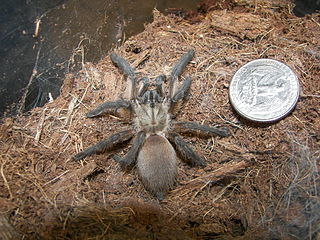
The Eumenophorinae are a subfamily of tarantula spiders. They are known from genera distributed across Sub-Saharan Africa, the south of the Arabian peninsula, Madagascar and its associated islands, and parts of India.
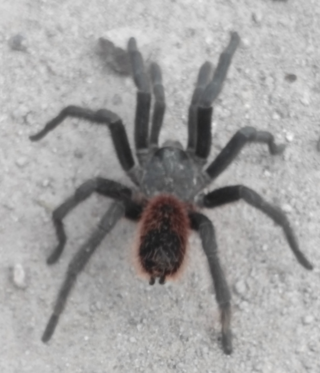
Aphonopelma caniceps is a species of spider in the family Theraphosidae, found in Mexico. This species was first described as Eurypelma caniceps in 1891 by Eugène Simon, and was transferred to the genus, Aphonopelma, in 1993 by Günter Schmidt.
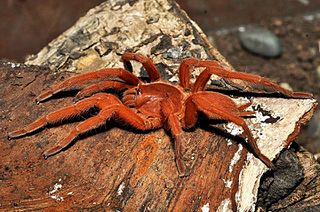
Orphnaecus is a genus of tarantulas that was first described by Eugène Louis Simon in 1892. They have close to fifty lanceolate stridulatory spines on the chelicerae, known as "strikers". The male embolus has a single strong retrolateral keel. It is considered a senior synonym of Chilocosmia and Selenobrachys.
Orphnaecus dichromatus is a species of selenocosmiine tarantula, in the Phlogiellini tribe.

Phlogiellus is a genus of tarantulas that was first described by Reginald Innes Pocock in 1897. They are found throughout Asia and Papua New Guinea, including Indonesia, the Philippines, Papua New Guinea, China, Myanmar, Malaysia, Borneo, Thailand, the Solomon Islands and Taiwan. Phlogiellus is part Latin and part Greek, the first part being "φλóξ φλoγóϛ", meaning flame, the second part being "ellus" which is a latin diminutive suffix.
Coremiocnemis is a genus of tarantulas that was first described by Eugène Louis Simon in 1892. They are named after the greek words korema, which means broom or brush, and kemis, meaning shin guard. Being a reference to the hirsute characteristics of the posterior legs.

Lampropelma is a genus of Indonesian tarantulas that was first described by Eugène Louis Simon in 1892. As of March 2020 it contains two species, found in Indonesia.
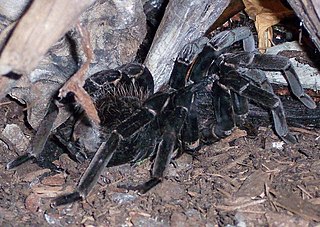
Xenesthis is a genus of tarantulas that was first described by Eugène Louis Simon in 1891. As of May 2020 it contains four species, found in Colombia and Venezuela, though it was previously considered to be found in Panama.
Rick C. West is a Canadian arachnologist and an expert on the taxonomy of tarantula spiders. West was born in Victoria, British Columbia. He has been interested in spiders since childhood, and collected his first tarantula, Aphonopelma eutylenum, at the age of 13. He worked primarily as a Chief Constable for a local Animal Humane Society, but also have been involved with the collecting, breeding, rearing and photography of theraphosid spiders. West has traveled to over 27 countries to document and study them in their environment, has been a host, presenter and co-producer in several tarantula documentaries and has also described several genera and species.

Avicularioidea is a clade of mygalomorph spiders, one of the two main clades into which mygalomorphs are divided. It has been treated at the rank of superfamily.

Trachycosmidae, is a family of spiders in the infraorder Araneomorphae.















